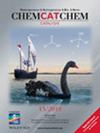Machine Learning‐Driven Selection of Two‐Dimensional Carbon‐Based Supports for Dual‐Atom Catalysts in CO2 Electroreduction
IF 3.8
3区 化学
Q2 CHEMISTRY, PHYSICAL
引用次数: 0
Abstract
The electrocatalytic reduction of carbon dioxide by metal catalysts featuring dual‐atomic active sites, supported on two‐dimensional carbon‐nitrogen materials, holds promise for enhanced efficiency. The potential synergy between various support materials and transition metal compositions in influencing reaction performance has been recognized. However, systematic studies on the selection of optimal support materials remain limited, primarily due to the intricate structure of dual‐atom catalysts generating a variety of potential adsorption sites. Incorporating the influence of support materials further amplifies computational challenges, doubling the already substantial calculation requirements. This study addresses this challenge by introducing a machine learning approach to expedite the identification of the most stable intermediate adsorption sites and simultaneous prediction of adsorption energy. This innovative method significantly reduces computational costs, enabling the simultaneous consideration of active sites and support materials. We explore the use of both graphene‐like (g‐)C2N and g‐C9N4 materials, revealing their main distinction in the adsorption capacity for the intermediate *CHO. This variation is attributed to the different C:N ratios influencing support for the active site through distinct charge transfer conditions. Our findings offer valuable insights for the design and optimization of dual‐atom catalysts.机器学习驱动的二氧化碳电还原双原子催化剂的二维碳基载体选择
以二维碳氮材料为支撑、具有双原子活性位点的金属催化剂对二氧化碳进行电催化还原,有望提高效率。各种支撑材料和过渡金属成分在影响反应性能方面的潜在协同作用已得到认可。然而,有关最佳支撑材料选择的系统研究仍然有限,这主要是由于双原子催化剂结构复杂,会产生各种潜在的吸附位点。考虑到支撑材料的影响,进一步加大了计算难度,使本已十分庞大的计算需求翻了一番。为了应对这一挑战,本研究引入了机器学习方法,以加快识别最稳定的中间吸附位点,并同时预测吸附能量。这种创新方法能同时考虑活性位点和支撑材料,大大降低了计算成本。我们探索了类石墨烯(g-)C2N 和 g-C9N4 材料的使用,发现了它们在中间体 *CHO 吸附能力上的主要区别。这种差异归因于不同的 C:N 比率通过不同的电荷转移条件影响了对活性位点的支持。我们的研究结果为双原子催化剂的设计和优化提供了宝贵的见解。
本文章由计算机程序翻译,如有差异,请以英文原文为准。
求助全文
约1分钟内获得全文
求助全文
来源期刊

ChemCatChem
化学-物理化学
CiteScore
8.10
自引率
4.40%
发文量
511
审稿时长
1.3 months
期刊介绍:
With an impact factor of 4.495 (2018), ChemCatChem is one of the premier journals in the field of catalysis. The journal provides primary research papers and critical secondary information on heterogeneous, homogeneous and bio- and nanocatalysis. The journal is well placed to strengthen cross-communication within between these communities. Its authors and readers come from academia, the chemical industry, and government laboratories across the world. It is published on behalf of Chemistry Europe, an association of 16 European chemical societies, and is supported by the German Catalysis Society.
 求助内容:
求助内容: 应助结果提醒方式:
应助结果提醒方式:


